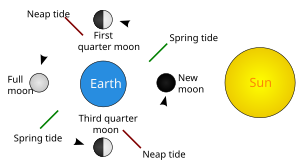
Posted on 03/10/2011 4:34:28 PM PST by americanophile
On March 19, the moon will swing around Earth more closely than it has in the past 18 years, lighting up the night sky from just 221,567 miles (356,577 kilometers) away. On top of that, it will be full. And one astrologer believes it could inflict massive damage on the planet.
Richard Nolle, a noted astrologer who runs the website astropro.com, has famously termed the upcoming full moon at lunar perigee (the closest approach during its orbit) an "extreme supermoon."
When the moon goes super-extreme, Nolle says, chaos will ensue: Huge storms, earthquakes, volcanoes and other natural disasters can be expected to wreak havoc on Earth. (It should be noted that astrology is not a real science, but merely makes connections between astronomical and mystical events.)
But do we really need to start stocking survival shelters in preparation for the supermoon? [Photos: Our Changing Moon]
The question is not actually so crazy. In fact scientists have studied related scenarios for decades. Even under normal conditions, the moon is close enough to Earth to make its weighty presence felt: It causes the ebb and flow of the ocean tides.
The moon's gravity can even cause small but measureable ebbs and flows in the continents, called "land tides" or "solid Earth tides," too. The tides are greatest during full and new moons, when the sun and moon are aligned either on the same or opposite sides of the Earth.
(Excerpt) Read more at news.yahoo.com ...
That's what I heard, come to think of it. Something about the crime rate perhaps.
It would be interesting to see statistical information.
To my understanding, the pro-(I don't know what to call them) moon people say that it's gravity pulls on the fluid in our brains, much like the tides.
Ah Crap! A weekend. Why couldn’t it be a Monday.
I’ve worked in the Mental Health field in the past. The looney bin gets even loonier during full moon. The weirdos get weirder. I’ve spoken with EMT’s and paramedics who see similar effects on disturbed individuals and patients during a full moon. My wife is a nurse in an Alzheimer’s wing of a nursing home. The last full moon set all of them off.
A full moon = opposite side of the earth from the sun. Therefore the tidal effects in the earth on and the seas will be countered by the sun’s pull.
Maybe if we all go out and bark at it........
What “massive damage” occurred 18 years ago at last close encounter?

The shadow of your smile, it calls to me.
They interviewed an ASTROLOGER for this???
Gimme a break!

more closely than it has in the past 18 years, lighting up the night sky from just 221,567 miles (356,577 kilometers)
IOW, ~900 km closer than 2004...0.25% closer.
Mar 8 1993 8:36 356529 km: so did the world end in 1993, when the distance was almost identical?
How about 1975? Feb 25 21:58 356519 km...oh, even closer yet!
Guess I won't worry this time, either.
See post#31. Storm of the Century occurred March 12-13,1993 and close full moon was March 8th. That was one hell of a storm. Look it up if you weren’t affected.

Higher tides occur with a full moon because the Sun's gravity is added to the "pull"

The semidiurnal range (the difference in height between high and low waters over about a half day) varies in a two-week cycle. Approximately twice a month, around new moon and full moon when the Sun, Moon and Earth form a line (a condition known as syzygy[8]) the tidal force due to the Sun reinforces that due to the Moon. The tide's range is then at its maximum: this is called the spring tide, or just springs. It is not named after the season but, like that word, derives from an earlier meaning of "jump, burst forth, rise" as in a natural spring. When the Moon is at first quarter or third quarter, the Sun and Moon are separated by 90° when viewed from the Earth, and the solar gravitational force partially cancels the Moon's. At these points in the lunar cycle, the tide's range is at its minimum: this is called the neap tide, or neaps (a word of uncertain origin). Spring tides result in high waters that are higher than average, low waters that are lower than average, slack water time that is shorter than average and stronger tidal currents than average. Neaps result in less extreme tidal conditions. There is about a seven-day interval between springs and neaps.
FrogDad said, "Well, I like this plan, but do we HAVE to panic?"
My Mother spent years as a dispatcher for her local Sheriff's department. She has said that she never believed this BEFORE her years working with the police.
Hey, when Cat Stevens was followed by that moon shadow he went crazy Islamic.
But alorejr says,,,but but
OMG! This is bound to be at least TWICE as horrific as Y2K.
Just think, those of us who survived that one will now have to face the supermoon. Certainly not fair./S
I spent my teen years in the eighties, and that's the nice thing about music.
I sure you've experienced it; you hear a song and it triggers good memories. "I was walking on the beach with my girl"...or "Yeah, remember that time when...".
In your 80’s?
I have heard so much anecdotal evidence supporting the idea that I think there could be something to it. I'm a fence sitter on this one; however, I always try to keep an open mind.
Disclaimer: Opinions posted on Free Republic are those of the individual posters and do not necessarily represent the opinion of Free Republic or its management. All materials posted herein are protected by copyright law and the exemption for fair use of copyrighted works.